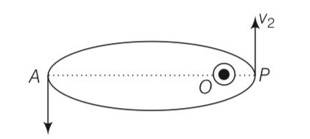A particle moves in a closed orbit around the origin, due to a force which is directed towards the origin. The de-BrOglie wavelength of the particle varies cyclically between two values λ1, λ2 with λ1> λ2 Which of the following statements are true?
(a) The particle could be moving in a circular orbit with origin as centre
(b) The particle could be moving in an elliptic orbit with origin as its focus
(c) When the de-Broglie wavetength is λ1the particle is nearer the origin than when its value is λ2
(d) When the de-Broglie wavelength is λ2 the particle is nearer the origin than when its value is λ1
Answer-(b,d)
A particle moves in a closed orbit around the origin, due to a force which is directed towards the origin. The de-BrOglie wavelength of the particle varies cyclically between two values λ1, λ2 with λ1> λ2 Which of the following statements are true?
(a) The particle could be moving in a circular orbit with origin as centre
(b) The particle could be moving in an elliptic orbit with origin as its focus
(c) When the de-Broglie wavetength is λ1the particle is nearer the origin than when its value is λ2
(d) When the de-Broglie wavelength is λ2 the particle is nearer the origin than when its value is λ1
Answer-(b,d)
-
1 Answer
-
This is a Multiple Choice Questions as classified in NCERT Exemplar
Explanation- the debroglie wavelength of the particle can be varying cyclically between two values and , if particle is moving in an elliptical orbit with origin as its focus.

Let v1, v2, be the speed of particle at A and B respectively and origin is at focus O. If and are the de-Broglie wavelengths associated with particle while moving at A and B
respectively. Then,
=h/mv1
=h/mv2
>
So v2>v1
By law of conservation of angular momentum, the particle moves faster when it is closer to
focus.
From figure, we note that origin O is closed to P than A
Similar Questions for you
Based on theory
z² × (13.6) (1 - ¼) = 3 × (13.6)
z = 2 . (i)
h/√2mk? = (1/2.3) × h/√2mk?
=> k? = (2.3)²k? = 5.25k? (ii)
Now, k? = E? - Φ
k? = E? - Φ = z²E? - Φ
∴ k? /k? = (10.2 - Φ)/ (4 × 10.2 - Φ) = 1/5.25
=> Φ = 3eV
- (i)
- (ii)
from (i) & (ii)
ev
hu = hu0 + K.E
Cases u = 2u0
h2u0 = hu0 + K.E1
K.E1 = hu0
- (1)
Now, cases 2
h 5u0 = hu0 + k.E2
k.E2 = 4hu0
v2 =
v2 = 2v1
This is a Short Answer Type Questions as classified in NCERT Exemplar
Sol:
Taking an Exam? Selecting a College?
Get authentic answers from experts, students and alumni that you won't find anywhere else
Sign Up on ShikshaOn Shiksha, get access to
- 65k Colleges
- 1.2k Exams
- 679k Reviews
- 1800k Answers
